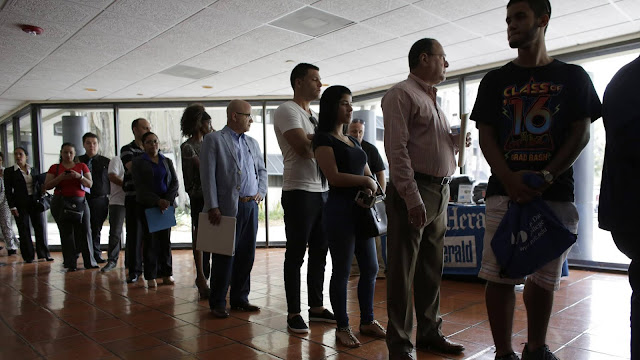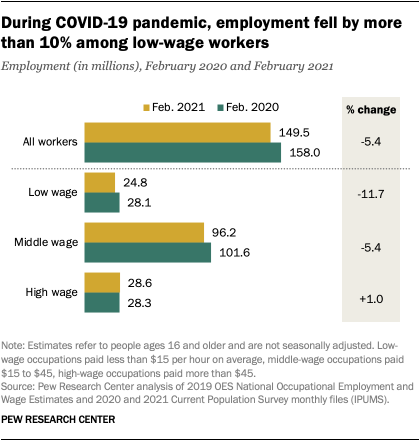We took a look at an April 14, 2021 article published by the reliable Pew Research Center entitled, A year into COVID-19, U.S. labor market recovery is far from complete | Pew Research Center, and we break it down for you here (along with some cool pics).
More Women Have Left the Workforce Since the Start of Pandemic Than Did Men
From February 2020 to February 2021, there was a net loss of 2.4 million women and 1.8 million men from the American labor force (i.e. were neither working nor actively looking for a job) – representing drops of 3.1% and 2.1%, respectively.
NOTE: Although Pew characterizes those who are not actively looking for work as having "quit" the workforce, we do not necessarily subscribe to that characterization.
From February 2020 to February 2021, 582,000 Hispanic women and 511,000 Black women left the labor force. This is a total of 1,093,000, or 46% of the 2.4 women in total. To get a better perspective on this, consider: Hispanic and Black women account for approximately one-third (33.33%) of the female labor force in the U.S.
Here is what Pew had to say about this phenomena:
One reason Hispanic women may have been more likely to leave the labor force is that they have a greater presence than other women or men in the leisure and hospitality sector. This sector has shed more jobs than any other sector in the economy from February 2020 to February 2021. Pandemic-driven pressures on parents may also have affected Hispanic, Black and Asian women more than White women. Compared with other women with children at home, Hispanic and Black women are more likely to be unpartnered parents.
NOTE: For Bureau of Labor and Industry ("BLI") statistical purposes, "[p]ersons whose ethnicity is identified as Hispanic or Latino may be of any race." In a 2018 Report, BLI stated "[t]he majority of Hispanics in the labor force were White (89%), 4 percent were Black and 1 percent were Asian."
As of February 2021, the Unemployment Rate for Men was Higher Than Was the Unemployment Rate for Women
In February 2021, women were unemployed at a rate of 6.1%, as compared to their counterparts, who were at 7%.
What is The United States Government's Definition of Unemployed?
NOTE: As per BLS , one is only "unemployed" if he/she "made at least one specific, active effort to find a job during the 4-week period ending with the survey reference week." Hence, the comparison of how many people left the workforce (2.4 million) during the pandemic versus the current unemployment rate is not an apples to apples comparison, since some who left the workforce did not actively seek work during the referenced time frame. It is generally understood that unemployment rates do not accurately represent true unemployment figures, and typically understate them by several percentage points. The Pew article discusses this in greater detail.
As of February 2021, Black and Hispanic Workers Suffered Highest Rates of Unemployment in the United States
Roughly 10% of Black and Hispanic workers were unemployed in February 2021.
Among Black women, the rate was 9.2% (down from a high of 17.3% in May 2020).
Among Black men, the rate was 11.6% (down from a high of 16.1% in June 2020).
Among Hispanic women, the rate was 8.9% (down from a high of 20.5% in April 2020).
Among Hispanic men, the rate was 9% (down from a high of 16.9% in April 2020).
In February 2021, the Unemployment Rate for White Women Was Down Significantly from its High Point in 2020
The unemployment rate for White women in February 2021 was 4.7% (down from a high of 14.2% in April 2020).
White Men Had the Least Fluctuation in Unemployment as a Result of the Pandemic
The unemployment rate for White men in February 2021 was 5.6% (down from a 2020 Pandemic high of 11.6%).
February 2021: Asian Men and Women Unemployment Rates Roughly on Par With White Men and Women
In February 2021, the unemployment rate for Asian women was 5.9% (down from a 202 Pandemic high of 16.7%).
Among Asian men, the rate was 4.5% (down from a 202 Pandemic high of 13.4%).
As per Pew:
From February 2020 to February 2021, employment among low-wage workers fell by 11.7%, from 28.1 million to 24.8 million. This compares with a loss of 5.4% among middle-wage workers, whose employment fell by 5.5 million over the period. Meanwhile, employment among high-wage workers was roughly unchanged, at slightly more than 28 million.
The reason for this pattern is that the COVID-19 recession is centered in the services sector, especially in the leisure and hospitality industry, which has been hit hardest in the pandemic and accounts for many of the low-wage jobs. The trend in the current recession stands in contrast with the Great Recession, which saw middle-wage occupations shed jobs at a higher rate than other occupations.
We hope that you found all of the above informative!
You May Find These Articles Worthwhile:







